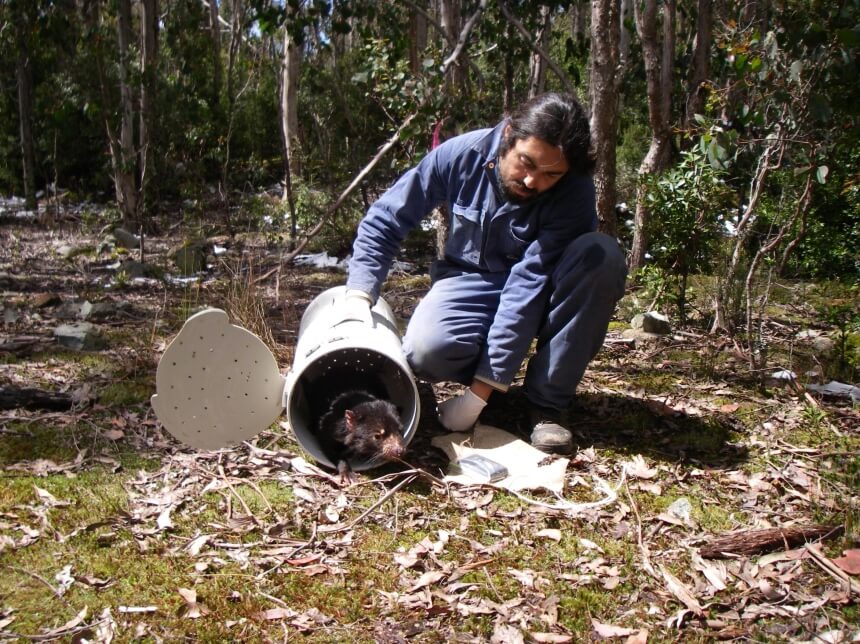Tasmanian Devils in the Channel region are now fighting not one, but two transmissible facial tumours - Tasmanian devil facial tumour disease (DFTD), which has now been around for some 25 years, and the newer devil facial tumour two (DFT2), discovered in the Cygnet area around five years ago.
New research from the University of Tasmania, published in the leading journal Evolutionary Applications, suggests that DFT2 is currently confined to the Channel region.
Since 2014, 40 DFT2 tumours - as well as 51 DFTD cases - have been confirmed on the Channel peninsula and its surroundings.
Dr Rodrigo Hamede from the University of Tasmanian’s School of Natural Sciences said that he believes, however, that it is only a matter of time until the new tumours are spread outside the area.
“Once devils get infected, they move with the disease and they infect other animals, and the disease is spread in the landscape and there’s not much we can do in terms of trying to stop it,” said Dr Hamede.
What researchers can do, though, is monitor the disease and how it is evolving and how it is affecting the devil population, which is why it has been so important that university researchers have had the full cooperation of the local community in conducting their studies.
Dr Hamede said that when the study started in 2015 researchers were unsure whether it would even be possible.
“Usually, when we work in other parts of the state, it is in state forests or national parks or areas that are easy to access,” he said.
“But because of the residential nature of the area where this disease emerged, if we don’t have landowners allowing us to trap on their properties, there’s nothing we can do about it.
“But we started with half a dozen landowners, and then it was up to 20, then 30, then 50, and so far we have not had a single negative response, which is absolutely astonishing.”
The new study, conducted in collaboration with institutions in Australia, USA, France and the UK, has now assessed the distribution, epidemiology and evolutionary interactions of both transmissible cancers.
DFT2 originated from a male devil, unlike DFTD, which originated from a female, and that might explain why DFT2 is affecting mostly males.
The current hypothesis suggests that females might be able to recognise Y- chromosome antigens and be less susceptible to DFT2 infection, but these patterns can change very quickly.
“Both cancers are now competing for the same resource, and that resource is the devil, “ said Dr Hamede.
“This may explain why DFT2 tumours are found not just on the head, as in DFTD, but also on the body, with non-facial tumours much more common in DFT2.”
Dr Hamede said that the study would continue for at least another three to four years, and probably longer, dependent on funding.
“We have been lucky enough that the local community really cares about devils, really cares about wildlife, and they’re aware that they are in an area of Tasmania where they coexist with them,” said Dr Hamede.
“They know better than us, because they listen to them, they see them, and having that connection with a species that is quite iconic, and has now been affected not by one, but now two transmissible cancers, it’s probably also what is making the difference for people to say yes, we want to collaborate.”
Transmissible cancers are known only to occur in domestic dogs, marine bivalves and Tasmanian devils.
So the fact that devils have been struck twice is no coincidence, according to Dr Hamede.
“Devils might be particularly prone to transmissible cancers, and somehow this could be good news for devils,” he said.
“If devils have had two transmissible cancers in just 25 years, then they may have been affected by these tumours several times during their evolutionary history.
“And if they are still here, fighting and learning how to live with cancer, then they may also know how to overcome these transmissible tumours.”
Dr Hamede said that he hopes that local community members will continue to cooperate with researchers in the future.
“What the community has done so far, it’s a lot,” said Dr Hamede.
“This work is the result of their cooperation, and there is absolutely no way we could have done this without them.
“So in a sense it’s citizen science, it’s their own research, and we hope they can keep doing it in the future.”
Don't miss this story and much more local news in this week's Huon News.


